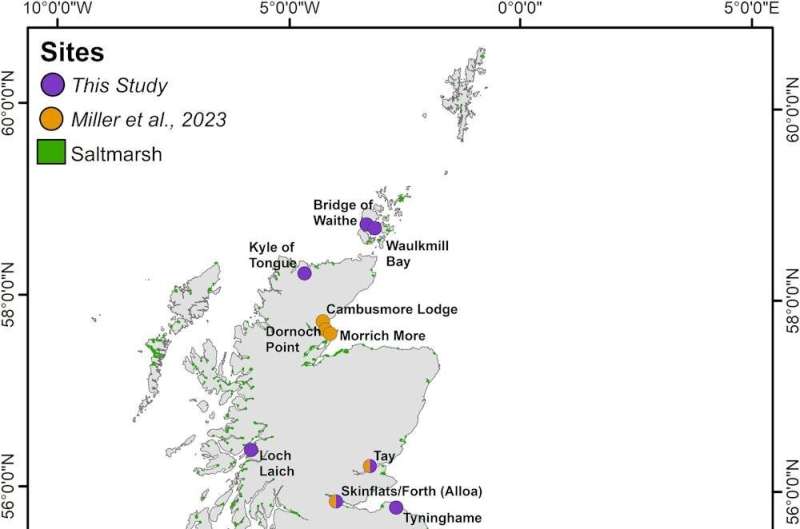This article has been reviewed according to Science X's editorial process and policies. Editors have highlighted the following attributes while ensuring the content's credibility:
fact-checked
trusted source
written by researcher(s)
proofread
Saltmarshes do store carbon, but their climate impact may have been overestimated

Saltmarshes, or tidal marshes, are able to capture carbon dioxide from the atmosphere and lock it away at a far higher rate than even forests on land. This has lead to them being championed as a nature-based solution to climate change. However, our research suggests the role played by saltmarshes of the UK and north-west Europe more widely in reducing the amount of carbon in the atmosphere has been significantly overestimated.
The UK has bold climate targets, including an ambition to incorporate carbon stored in saltmarshes in its national greenhouse gas reporting, while also developing plans to fund marsh restoration by selling the carbon they store to those wanting to offset emissions elsewhere.
The foundation for these plans is the assumption that every year each square meter of saltmarsh soil traps about 245 grams of carbon. However, this is a global average value, largely based on the carbon-rich saltmarshes of Australia and coast of the Gulf of Mexico. These areas are warm so plants grow quickly and easily, which ultimately leads to lots of carbon going into the soil.
This raises the question of whether saltmarshes in the cooler and less sunny UK can really trap and store as much carbon as those in the tropics. If the answer is no, what does this mean for the UK's climate plans?
The UK's reality
Over the past seven years, we have collected thousands of soil and vegetation samples from saltmarshes all over Scotland, England and Wales. To calculate the amount of carbon stored we used an elemental analysis machine, which burns the soil at high temperatures and detects which gases are released.
We estimate that these saltmarshes store 5.2 million tons of carbon. But, on average, they only trap around 111 grams of extra organic carbon in each square meter per year. This rate is much lower than the global saltmarsh average but similar to that of UK forests.
This difference between the UK and global carbon accumulation rates (111g v 245g per year) may sound small but would result in significant overestimation in a marsh's ability to store carbon.
For example, if we take Caerlaverock saltmarsh on the Solway Firth in Scotland, we estimate that each year 754 tons of carbon accumulates. If we use the global average carbon accumulation rate, this would increase to 2,339 tons of carbon, a 3x overestimation.
Saltmarsh covers 452km² of the UK coastline which is small in comparison to other hotpots for carbon capture and storage such as forests (32,500km² in the UK). This means less than 50,000 tons of carbon accumulate in saltmarshes each year (for context, the UK emits around 117 million tons of carbon per year).
Additionally, we found that around 30% of this carbon has floated in on the tides after originally being captured from the atmosphere by seaweed, plankton, and other marine life. A further—currently unknown—proportion of the carbon originates from plants that grew on dry land and have been washed down rivers and into marshes. This means that only a fraction of the 50,000 tons is directly taken from the atmosphere by the saltmarsh, further highlighting that they have only a small direct impact on the climate.
Shifting the perspective
Our new estimates should lead to a policy shift, since the climate benefits of the new carbon accumulating in saltmarshes are tiny compared to the benefits of protecting the marshes (and their already-stored carbon) in the first place.
Creating new areas of saltmarsh can also protect the coast from erosion and provide new habitat for plants and animals. But a greater emphasis must be placed on preserving existing saltmarshes from threats like rising seas or coastal defenses being built to protect farmland.
Given the size of the existing stock of carbon and the slower rate at which this increases, we emphasize the vital and urgent need to protect the carbon already locked in saltmarsh soils. The development of policy and management strategies to protect and preserve this carbon must now be a priority.
Provided by The Conversation
This article is republished from The Conversation under a Creative Commons license. Read the original article.![]()




















